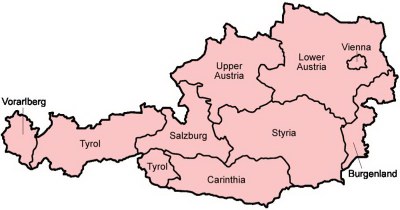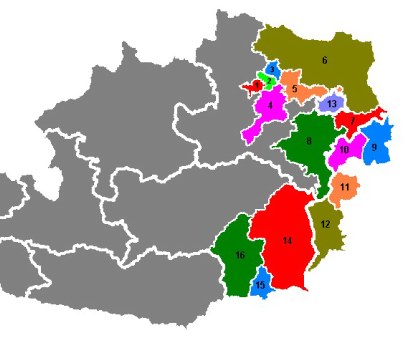 |
Fine Wine Estates from Austria
|
Austrian Wine Regions

Lower Austria (Niederösterreich)
Wachau
This narrow valley of the Danube around Melk is reminiscent of the great wine areas of the Rhine, with steep terraces that produce world-class Grüner Veltliner and Riesling wines. Climatically and geologically it marks the transition from the Alps to the Hungarian plains, leading to a diverse array of microclimates and terroir, with the river moderating the effects of the cold Alpine winds. As mentioned above, the Vinea Wachau Nobilis Districtus still clings to its own classification of Steinfeder, Federspiel and Smaragd, reserved for wines that are made 100% from Wachau grapes.
Kremstal
Downstream of the Wachau lies the Kremstal region, centered on the town of Krems. The valley opens out a little, the climate is a little warmer allowing more red wine to be produced, but otherwise Kremstal is quite similar to the Wachau.
Kamptal
To the north of Krems lies Langenlois, which is the main town of Kamptal, the valley of the river Kamp. The sandstone slopes are so steep that only a thin layer of soil is retained, and the sun here can 'burn like hell' - hence the name of the most famous vineyard, the Heiligenstein ('Hell stone'). Riesling thrives on these steep slopes; closer to the Danube the valley broadens and more red grapes are grown.
Traisental
To the south of Krems lies Herzogenburg, at the center of Traisental, which was only designated as a wine district in 1995. Mostly Grüner Veltliner is grown here, which is made into a fresh style for drinking young.
Wagram
Between Krems and Vienna lies the Wagram, previously known as Donauland, which covers two very different areas. North of the Danube is the plateau of Wagram, where the Grüner Veltliner is a bit more full-bodied and aromatic, and Roter Veltliner is something of a local specialty. Blauer Zweigelt and Pinot Noir wines are also made here, as well as a little Eiswein.
Further downstream, just outside Vienna lies Klosterneuburg. As the biggest private wine estate in the country, the abbey has played a formative role in Austrian wine for the last 900 years. The Federal Institute for Viticulture and Pomology was the world's first college of viticulture and continues to play an important part in the development of wine in Austria.
Weinviertel
The Weinviertel lies in the northeast corner of Austria, between the Danube and the Czech & Slovak borders. The biggest single wine region in Austria is home to half the Grüner Veltliner in the country (subject of the first DAC), and considerable amounts of Welschrielsing, but most of Austria's varieties can be found here. Even sparkling wine is made from Riesling and Grüner Veltliner in the far northeast around Poysdorf, a particularly picturesque town in a country with more than her fair share of pretty wine country.
Carnuntum
The deep soils between Vienna and the Neusiedlersee are rapidly establishing a reputation for well-balanced red wines made from Zweigelt and Blaufränkisch. Being close to Vienna and full of history, the area is a popular area to visit.
Thermenregion
The spa region south of Vienna saw two wine regions, Gumpoldskirchen and Bad Vöslau, merged in 1985. Climatically similar to Burgundy, with a wide variation in soils, all kinds of grape varieties are made here, many being made into heurigen wines. Perhaps the most interesting wines are the Spätrot-Rotgipflers, made from a blend of the local varieties Zierfandler (Spätrot) and Rotgipfler, both of which are white grapes despite their names.
Burgenland
Neusiedlersee
The east side of the Neusiedler See is also known as Seewinkel, 'corner of the lake'. The shallow Neusiedler See (Lake Neusiedl) is one of the few places on earth where noble rot attacks grapes reliably every year. This means that botrytised dessert wines can be made more easily, and hence sold more cheaply, than in other areas famous for this style of wine. Increasingly, red wine is also being made in this region.
Neusiedlersee-Hügelland
The 'hill country' to the west of the lake offers a diversity of terrain that is reflected in the number of grape varieties and styles of wine made here. Perhaps the most famous is the Ruster Ausbruch dessert wine from the western shore of the lake.
Mittelburgenland
The Mittelburgenland is a southern continuation of the forested hills to the west of the Neusiedlersee. The nickname "Blaufränkischland" reflects the dominant variety here, which is the subject of the only red wine DAC and can be very good, the Bordeaux varieties also do well here.
Südburgenland
The most famous vineyard of the South Burgenland - Eisenberg - reflects the red, iron-rich soil which imparts a distinct spiciness to the Blaufränkisch grown here. A specialty here is Uhudler wine, made from hybrids with North American species such as Isabella, Concord, Delaware, Noah, Elvira and Ripadella, which was banned for a while after the 1985 scandal.
Vienna (Wien)
Wien
Even the French and Italians don't have 621ha of vineyards within the city limits of their capital. But vines were grown within the city walls of Vienna in the Middle Ages, although they have now been pushed into the outskirts. Riesling, Chardonnay and Pinot Blanc are grown on the limestone soils towards Klosterneuburg, whereas red grapes do better on the rich soil to the south of the city. Field blends known as Gemischter Satz are common here, and most wine is drunk young in the city's heurigen.
Styria (Steiermark)
Under a 2002 amendment to the wine laws, Steirerland (the modern Austrian province) replaced Steiermark (the old duchy, which included the eastern half of modern Slovenia) as the name for Styria on wine.
Südoststeiermark
The many extinct volcanoes east of Graz give a rich soil which impart a spiciness to the variety of grapes grown in Southeast Styria. The climate is a little cooler here.
Südsteiermark
The warm humid climate and steep hills make this one of the toughest places in Austria to be a vigneron. A variety of white grapes are grown here, including Welschriesling and some notable Sauvignon Blancs (Muskat Sylvaner).
Weststeiermark
Southwest of Graz lie ancient vineyards which mainly produce a cult rosé called Schilcher. Made from the indigenous Blauer Wildbacher grape, genuine Schilcher carries a mark with a white horse, after the Lipizzaners bred in Piber for the Spanish Riding School in Vienna.
-Information provided by Wikipedia
|
AustrianWineEstates Site Search
|
